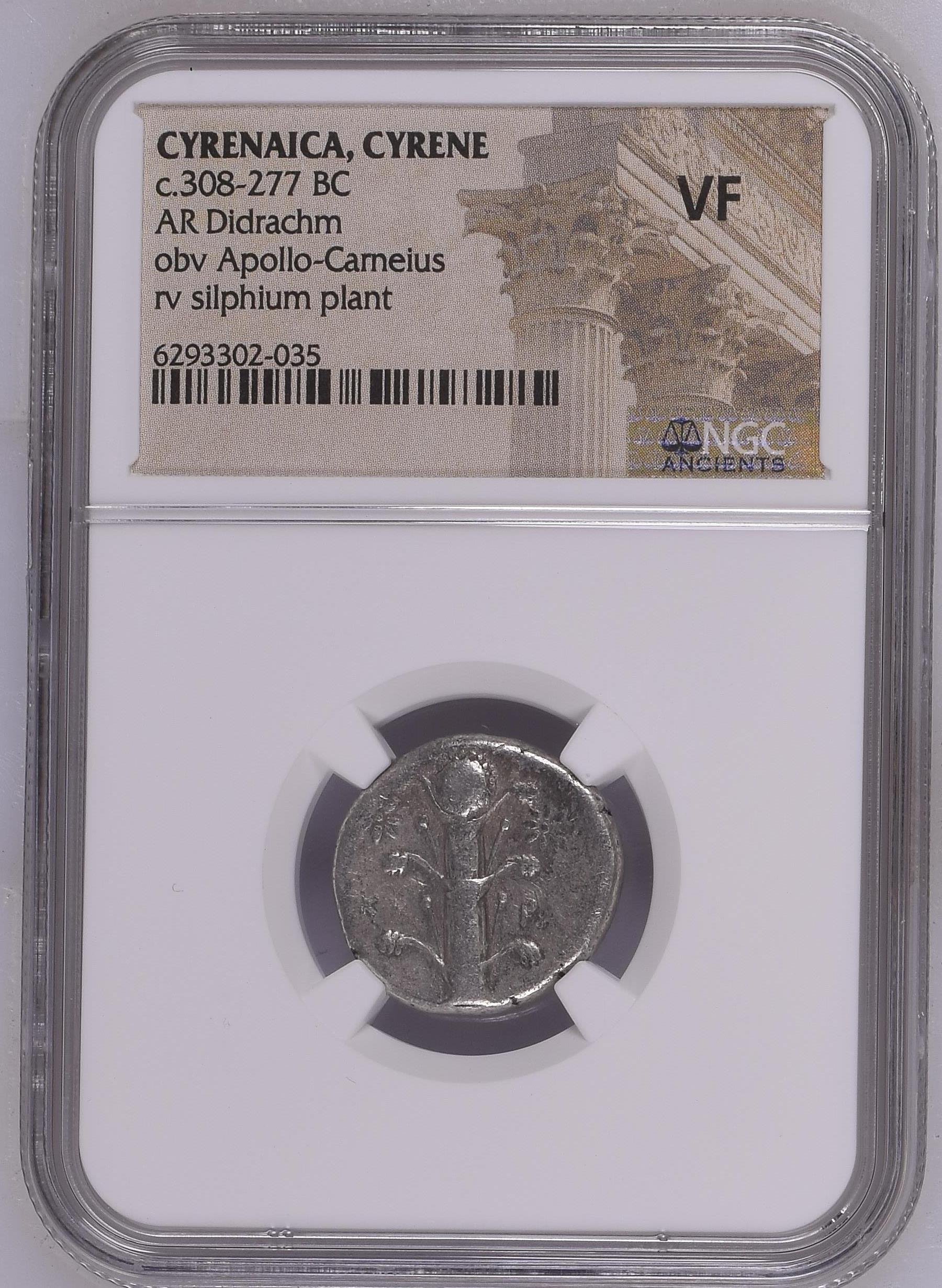 Image 1 of 2
Image 1 of 2

 Image 2 of 2
Image 2 of 2



Ancient Greek Silver Didrachm from Cyrene (about 2,325-2,300 years ago)
This is a silver coin from the ancient Greek colony of Cyrene in North Africa (modern Libya), minted during the early Hellenistic period following Alexander the Great's conquests.
Coin Description:
Front side (Obverse): Features Apollo-Carneius, a regional variation of the Greek god Apollo
Back side (Reverse): Depicts the silphium plant, a now-extinct medicinal herb that was the economic foundation of Cyrene
Technical Details:
Silver composition (AR)
Didrachm denomination (standard Greek silver coin)
Certified by NGC with grade VF (Very Fine)
Minted during 308-277 BCE
Historical Significance: This coin was produced in Cyrenaica, a fertile region in North Africa colonized by Greeks from the island of Thera (modern Santorini) in the 7th century BCE. The city of Cyrene became immensely wealthy through its monopoly on silphium, a plant so valuable it was worth its weight in silver and featured prominently on their coinage. The image of Apollo-Carneius reflects the religious traditions of Cyrene, while the silphium plant symbolizes the source of the city's prosperity. This coin dates from the period when Cyrene was under Ptolemaic control following Alexander the Great's conquests, representing the spread of Greek culture and economics throughout the Mediterranean world.
This is a silver coin from the ancient Greek colony of Cyrene in North Africa (modern Libya), minted during the early Hellenistic period following Alexander the Great's conquests.
Coin Description:
Front side (Obverse): Features Apollo-Carneius, a regional variation of the Greek god Apollo
Back side (Reverse): Depicts the silphium plant, a now-extinct medicinal herb that was the economic foundation of Cyrene
Technical Details:
Silver composition (AR)
Didrachm denomination (standard Greek silver coin)
Certified by NGC with grade VF (Very Fine)
Minted during 308-277 BCE
Historical Significance: This coin was produced in Cyrenaica, a fertile region in North Africa colonized by Greeks from the island of Thera (modern Santorini) in the 7th century BCE. The city of Cyrene became immensely wealthy through its monopoly on silphium, a plant so valuable it was worth its weight in silver and featured prominently on their coinage. The image of Apollo-Carneius reflects the religious traditions of Cyrene, while the silphium plant symbolizes the source of the city's prosperity. This coin dates from the period when Cyrene was under Ptolemaic control following Alexander the Great's conquests, representing the spread of Greek culture and economics throughout the Mediterranean world.
This is a silver coin from the ancient Greek colony of Cyrene in North Africa (modern Libya), minted during the early Hellenistic period following Alexander the Great's conquests.
Coin Description:
Front side (Obverse): Features Apollo-Carneius, a regional variation of the Greek god Apollo
Back side (Reverse): Depicts the silphium plant, a now-extinct medicinal herb that was the economic foundation of Cyrene
Technical Details:
Silver composition (AR)
Didrachm denomination (standard Greek silver coin)
Certified by NGC with grade VF (Very Fine)
Minted during 308-277 BCE
Historical Significance: This coin was produced in Cyrenaica, a fertile region in North Africa colonized by Greeks from the island of Thera (modern Santorini) in the 7th century BCE. The city of Cyrene became immensely wealthy through its monopoly on silphium, a plant so valuable it was worth its weight in silver and featured prominently on their coinage. The image of Apollo-Carneius reflects the religious traditions of Cyrene, while the silphium plant symbolizes the source of the city's prosperity. This coin dates from the period when Cyrene was under Ptolemaic control following Alexander the Great's conquests, representing the spread of Greek culture and economics throughout the Mediterranean world.
Silphium is a genus of North American plants in the tribe Heliantheae within the family Asteraceae.[1][2]
Members of the genus, commonly known as rosinweeds, are herbaceous perennial plants growing to 0.2 m (8 in) to more than 2.5 m (8 ft 2 in) tall, with yellow (rarely white) flowerheads that resemble sunflowers. In the rosinweeds, the ray florets in the head are female and the disc florets are male;[3] this differs from sunflowers, where ray florets are sterile and disc florets are perfect, capable of producing both pollen and seeds.[4]












